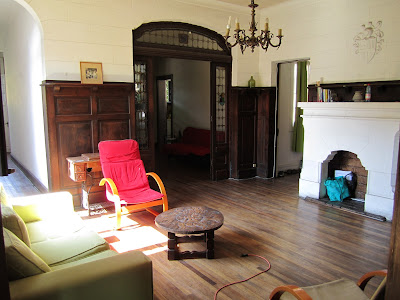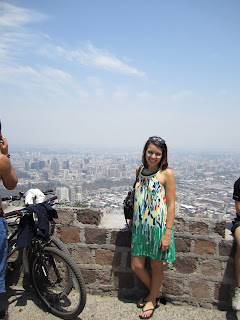Brothers, sisters, friends, comrades by the time you read this Jenn and I will have already flown to summer. Perhaps there is no better time than now to take a stab at the question that, over the past few months, has rented more space in my ears than the sweet nothings of a newlywed. Why Chile?
I could sit here and rattle off the depressingly obvious clichés about wanting to take the road less traveled, fulfill a sense of adventure, or broaden my horizons. If these fail to satisfy, an esoteric appeal to our Pleistocene heritage might suffice. We are, after all, a migratory species. We roamed the earth as hunter gathers for over 90% our species’ history. It would be surprising if we didn’t posses some kind of innate desire for travel—maybe even a traveling gene. Still not convinced? Me neither.
I could manufacture justifications about how learning Spanish will help Jenn and I in the future. Equally, my tongue could lay down a barrage of more meaningful reasons such as exploring the world of autism in a developing country or finding and meeting Jenn’s Chilean side of the family. I am sure many of you, at one time or another, have heard a variety of these justifications. Each are at least partly true and have at different times helped me tack through the waters of social pleasantries, but realistically I am unable to perform the mental gymnastics to convince myself that any one of them is a truly honest answer. And I don’t think I’m fooling anyone else either.
If I could muster the nerve I’d rather respond that I don’t particularly want an answer. Not that I just don’t have one, but I don’t want one. Of course this response never scores conversational points in the annals of small talk. We are pattern-seeking primates that crave causal explanations for each and every event. This desire often leads us to impose patterns even where none exist—i.e. the Rorschach test. Nevertheless, we are constantly pushed and prodded by ourselves and others to justify our actions. Why landscape architecture? Why autism design? Why Ohio? Why Chile? Why anything? Without reasons and elaborate stories our actions somehow seem less intriguing, less meaningful.
Yet, life more likely resembles a drunkard’s walk than a sober calculated march toward an inevitable outcome. In this way, we go through life like a molecule stumbling around a glass of water. We zig this way and zag that way as we randomly collide with our chaotically moving sister H2O molecules. And although a molecule’s wandering is aimless, the molecule eventually makes progress in one direction. In hindsight, calculating its path is accurate, but predicting its course before the first jostle is only probabilistic. The term for this random motion is known in mathematics, for obvious reasons, as the drunkard’s walk, and is brilliantly used as a metaphor for life in a book I recently read. Each time we belly up to a new day we are served several pints of randomness and chance that can lead to significant life changing experiences. Looking back our current stations make perfect sense, but the closer we look the more random chance encounters we see and the less probable and more miraculous it seems that our lives have turned out the way they have.
Take for example the long arc from my childhood friendship with Jay T. to my work in autism design. From the outside my trajectory appears almost inescapable, but any barfly who knew me before I got interested in autism design would struggle to see the connection or its inevitability. First, Jay T.’s autism could have manifested itself without tactile or auditory issues. If that were the case I would never have initially tied autism to design. Secondly, my matriculation to Virginia Tech was far from a sure thing. Originally, I was on my way to the University of Arizona until a little indecision combined with the National Guard forgetting to transfer paperwork shelved that wildcat plan. In hindsight this stubble proved to be rather fortuitous because U of A did not have an undergraduate landscape architecture program and I had only chosen landscape architecture because of a random and fleeting interest in pool design. If that had not been an option I highly doubt I would have applied to any other design major.
What’s more, I floundered for around three years in landscape architecture before I made the connection between autism and design. And, even then I never dreamt the investigation going any further than a senior project. That was until I, for no apparent reason, decided to open a university scholarship spam mail. Normally, I would mark such correspondence for deportation to the nether regions of the email trash bin, but that day I clicked to uncover a call for undergraduate research papers. Without a concern for proofreading I sent along a paper I had recently finished on outdoor environments for individuals with autism. For whatever reason the review panel failed to recognize that the title of the paper was misspelled and the paper was accepted as one of four to represent Tech at the ACC Undergraduate Research Conference. I could go on about how all of this led me to Denmark, Hill Studio, writing a book and Bittersweet Farms in Ohio, but teasing out anymore happenstance moments would be rather tiresome and beyond the point.
Anywhere along this journey I could have easily stumbled down another Frostian path where way would have led on to way leaving me unable to return to the roads kept for another day. With that in mind, Jenn and I stagger into Chile without a comfortable explanation, but not particularly wanting one. We don’t know if we will find jobs, how long we will be here, or what impact it will have on the rest of our lives. All I can say is that if life is a drunkard’s walk the stumble home from the bar is best made with the friends you love. So here I am with Jenn drinking in life and hoping many of you will join/follow our bar crawl home.
Leonard Mlodinow The Drunkard’s Walk: How Randomness Rules Our Life



































